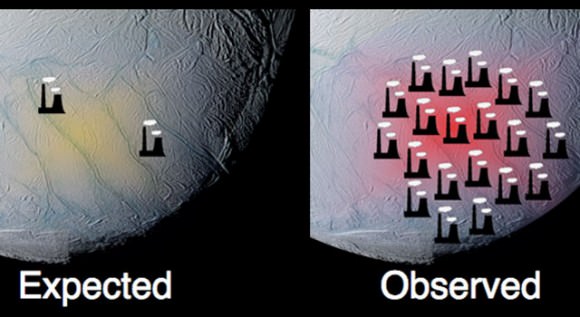[/caption]
The south polar region of Enceladus is turning out to be a veritable heat pump. The fissure- and geyser-laden region on this moon of Saturn is churning out internal heat-generated power of about 15.8 gigawatts, which is approximately 2.6 times the power output of all the hot springs in the Yellowstone region, or comparable to 20 coal-fueled power stations. This is more than an order of magnitude higher than scientists had predicted, according to Carly Howett, the lead author of a study published in the Journal of Geophysical Research on March 4. Just how that much power is being generated, however, is unknown.
“The mechanism capable of producing the much higher observed internal power remains a mystery and challenges the currently proposed models of long-term heat production,” said Howett.
2008 data from Cassini’s composite infrared spectrometer indicates a surprisingly high output of temperature from the south polar terrain on Enceladus, which makes it even more likely that liquid water exists below Enceladus’ surface, Howett said.
A 2007 study predicted the internal heat of Enceladus, if principally generated by tidal forces arising from the orbital resonance between Enceladus and another moon, Dione, could be no greater than 1.1 gigawatts averaged over the long term. Heating from natural radioactivity inside Enceladus would add another 0.3 gigawatts.
So these new readings come as a surprise.

Recently, scientists studying ice particles ejected from the plumes discovered that some of the particles are salt-rich, and are probably frozen droplets from a saltwater ocean in contact with Enceladus’ mineral-rich rocky core. The presence of a subsurface ocean, or perhaps a south polar sea between the moon’s outer ice shell and its rocky interior would increase the efficiency of the tidal heating by allowing greater tidal distortions of the ice shell.
“The possibility of liquid water, a tidal energy source and the observation of organic (carbon-rich) chemicals in the plume of Enceladus make the satellite a site of strong astrobiological interest,” said Howett, who is a postdoctoral researcher at Southwest Research Institute in Boulder, Colorado.
A possible explanation of the high heat flow observed is that Enceladus’ orbital relationship to Saturn and Dione changes with time, allowing periods of more intensive tidal heating, separated by more quiescent periods. This means Cassini might be “lucky” enough to be seeing Enceladus when it’s unusually active.
The activity is centered on four roughly parallel linear trenches, 130 kilometers (80 miles) long and about 2 kilometers (1 mile) wide, informally known as the “tiger stripes.” These fissures eject great plumes of ice particles and water vapor continually into space, and have elevated temperatures due to heat leaking out of Enceladus’ interior.
Along one fissure, called Baghdad Sulcus, temperatures exceed 180 Kelvin ( – 92 C, -135 F), and may be higher than 200 Kelvin (- 73 C, -100 F). While chilly by Earth standards, peak temperatures, the temperatures are a cozy oasis compared to the numbing 50 Kelvin (-223 C, -370 F) of their surroundings.
Source: JPL


Too bad all the simplest sources (tidal, impactor, stranded alien spaceship 😉 ) are all temporary or at least varying a lot.
I still think this is a better site to start investigating subsurface oceans that Europa. The stuff is thrown at you!
Given that the escape velocity for this NY state sized moon is about the same as the cruising speed of an airliner, it might actually make more sense as Torbjorn points out to land on the surface near the fissures. The fact that material is being dredged up from below and being flash frozen before being once again deposited is a real treasure trove of possibilites. It would seem fairly straight forward to collect the falling materials and continue to analize them over time. Anything that is under the surface will be brought up and delivered to you on a plate so to speak. There is no requirement for nuclear powered drilling hardware that nobody is going to build until maybe fusion technology becomes mainstream and widely accepted.
Think about it; it is like plate tectonics in fast motion. If the surface is young, then it must some how be subducted back into the crust and regenerated.
I keep thinking back about the book, ‘Out of the Cradle’ that I read when I was 18. That was in 1984. When every one was going on about George Orwell, I was mesmerized by the images in this book and I must have reread it many times as my family life was in a mess and this book kept me sane.
I was especaily intrigued by the images of explorers on the moons of Saturn and seeing all of the surface features up close. Man, what I wouldn’t give to go there and look around myself.